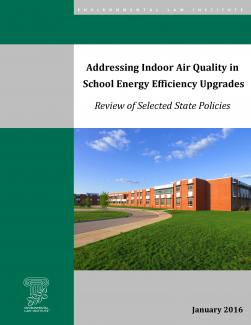
Energy efficiency retrofits can both conserve energy and improve indoor air quality. Early and ongoing consideration of IAQ issues during school energy upgrades is important for avoiding unintended, negative indoor environmental consequences and reaping the twin benefits of energy savings and a healthier, more productive school environment. EPA’s Energy Savings Plus Health guidelines for schools discuss strategies for addressing over 20 priority indoor air issues and contaminants commonly associated with school building upgrades. These issues include moisture/mold, lead-based paint, asbestos, polychlorinated biphenyls (PCBs), radon, and ventilation.
This report highlights examples of state policies in effect as of 2016 that advance the consideration of IAQ issues in the planning and implementation of school energy efficiency retrofit and renovation projects. Although the focus is on schools, the discussion may also be relevant to energy retrofits in other types of buildings.
Overview of the Report
The report discusses three policy approaches states have used to integrate IAQ goals into school energy retrofits.
Funding for School Facility Upgrades. States operate a variety of programs that provide grants, loans, and other financing for school energy efficiency retrofits. Some states have incorporated into these programs measures such as allowing energy-related IAQ improvements as eligible expenses and prioritizing funding for projects that include IAQ and other non-energy benefits.
Energy Savings Performance Contracting. Performance contracting allows a building owner to pay the installation and financing costs of an energy efficiency project over time, using the energy and maintenance savings generated by the project. State law typically governs the types of school projects that may be carried out through an Energy Savings Performance Contract (ESPC), as well as the terms of the contract. State laws often expressly allow IAQ measures to be carried out and financed through an ESPC, and some states have published guidance documents that emphasize the importance of IAQ considerations in the ESPC process and have developed model ESPC contracts that incorporate IAQ considerations.
Required IAQ Practices During School Renovations. States can ensure that school retrofit projects do not unintentionally create IAQ problems by establishing requirements for addressing indoor pollutant exposures during renovation projects. Certain hazardous substances, such as asbestos, lead, and PCBs are subject to federal regulatory requirements in the context of school renovations. Some states have adopted their own laws and regulations for addressing these and other contaminants, such as radon. In addition, a number of states require best practices for controlling indoor pollutants while renovations are underway in occupied spaces. Since publication of this report, new and revised federal and state policies have been adopted on some of these issues, such as lead-based paint and PCBs, which may impact how the issues are addressed during school retrofit projects.
Explore other materials from ELI’s Indoor Environments Program.
© Environmental Law Institute®